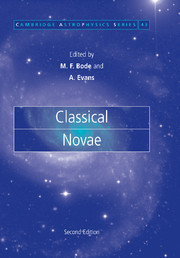Book contents
- Frontmatter
- Contents
- List of contributors
- Preface to the first edition
- Preface to the second edition
- List of symbols
- 1 Novae: an historical perspective
- 2 Properties of novae: an overview
- 3 The evolution of nova-producing binary stars
- 4 Thermonuclear processes
- 5 Nova atmospheres and winds
- 6 Observational mysteries and theoretical challenges for abundance studies
- 7 Radio emission from novae
- 8 Infrared studies of classical novae
- 9 Optical and ultraviolet evolution
- 10 X-ray emission from classical novae in outburst
- 11 Gamma-rays from classical novae
- 12 Resolved nebular remnants
- 13 Dust and molecules in nova environments
- 14 Extragalactic novae
- Object index
- Subject index
3 - The evolution of nova-producing binary stars
Published online by Cambridge University Press: 10 October 2009
- Frontmatter
- Contents
- List of contributors
- Preface to the first edition
- Preface to the second edition
- List of symbols
- 1 Novae: an historical perspective
- 2 Properties of novae: an overview
- 3 The evolution of nova-producing binary stars
- 4 Thermonuclear processes
- 5 Nova atmospheres and winds
- 6 Observational mysteries and theoretical challenges for abundance studies
- 7 Radio emission from novae
- 8 Infrared studies of classical novae
- 9 Optical and ultraviolet evolution
- 10 X-ray emission from classical novae in outburst
- 11 Gamma-rays from classical novae
- 12 Resolved nebular remnants
- 13 Dust and molecules in nova environments
- 14 Extragalactic novae
- Object index
- Subject index
Summary
Introduction
We discuss the evolution of both stellar components of cataclysmic variables (CVs) and symbiotic stars from formation to termination, identifying the modes and estimating the rates of mass tranfer as functions of the period of the system, and suggesting how the composition of the nova ejecta depends on the rate of mass transfer, the processes of mixing between accreted material and material in the underlying white dwarf, and the mass-transfer, mixing, and prior outburst history of the system.
Left completely out of the discussion is the disk component which, in CVs and perhaps in some symbiotic stars, mediates mass transfer between the mass donor and the white dwarf accretor. We begin with an outline of the topics to be discussed.
Definitions: CVs are here defined as close binary systems in which one component is a CO or ONe white dwarf and the other is a Roche-lobe-filling (or nearly Roche-lobe-filling) star which can be a main-sequence star, a small hydrogen-rich white dwarf, a red giant (Algol-like CV) or a helium white dwarf or helium main sequence star (helium CV). In symbiotic stars, the companion of the white dwarf is a red giant or Asymptotic Giant Branch (AGB) star which, in general, does not fill its Roche lobe.
[…]
- Type
- Chapter
- Information
- Classical Novae , pp. 34 - 76Publisher: Cambridge University PressPrint publication year: 2008
- 4
- Cited by



